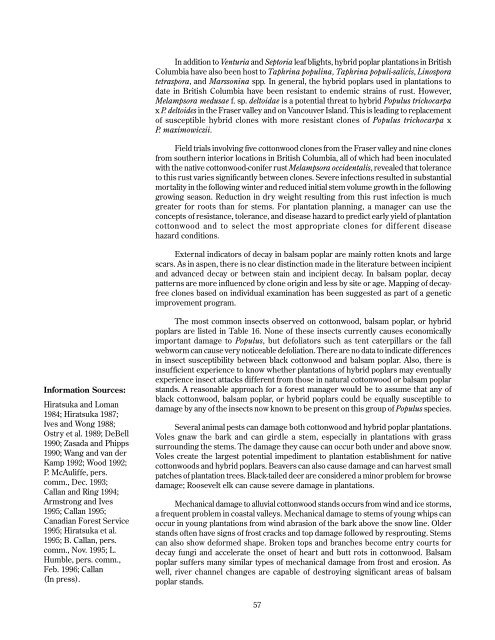FRDA Report: Black Cottonwood and Balsam Poplar Managers ...
FRDA Report: Black Cottonwood and Balsam Poplar Managers ...
FRDA Report: Black Cottonwood and Balsam Poplar Managers ...
Create successful ePaper yourself
Turn your PDF publications into a flip-book with our unique Google optimized e-Paper software.
Information Sources:<br />
Hiratsuka <strong>and</strong> Loman<br />
1984; Hiratsuka 1987;<br />
Ives <strong>and</strong> Wong 1988;<br />
Ostry et al. 1989; DeBell<br />
1990; Zasada <strong>and</strong> Phipps<br />
1990; Wang <strong>and</strong> van der<br />
Kamp 1992; Wood 1992;<br />
P. McAuliffe, pers.<br />
comm., Dec. 1993;<br />
Callan <strong>and</strong> Ring 1994;<br />
Armstrong <strong>and</strong> Ives<br />
1995; Callan 1995;<br />
Canadian Forest Service<br />
1995; Hiratsuka et al.<br />
1995; B. Callan, pers.<br />
comm., Nov. 1995; L.<br />
Humble, pers. comm.,<br />
Feb. 1996; Callan<br />
(In␣ press).<br />
In addition to Venturia <strong>and</strong> Septoria leaf blights, hybrid poplar plantations in British<br />
Columbia have also been host to Taphrina populina, Taphrina populi-salicis, Linospora<br />
tetraspora, <strong>and</strong> Marssonina spp. In general, the hybrid poplars used in plantations to<br />
date in British Columbia have been resistant to endemic strains of rust. However,<br />
Melampsora medusae f. sp. deltoidae is a potential threat to hybrid Populus trichocarpa<br />
x P. deltoides in the Fraser valley <strong>and</strong> on Vancouver Isl<strong>and</strong>. This is leading to replacement<br />
of susceptible hybrid clones with more resistant clones of Populus trichocarpa x<br />
P.␣ maximowiczii.<br />
Field trials involving five cottonwood clones from the Fraser valley <strong>and</strong> nine clones<br />
from southern interior locations in British Columbia, all of which had been inoculated<br />
with the native cottonwood-conifer rust Melampsora occidentalis, revealed that tolerance<br />
to this rust varies significantly between clones. Severe infections resulted in substantial<br />
mortality in the following winter <strong>and</strong> reduced initial stem volume growth in the following<br />
growing season. Reduction in dry weight resulting from this rust infection is much<br />
greater for roots than for stems. For plantation planning, a manager can use the<br />
concepts␣ of resistance, tolerance, <strong>and</strong> disease hazard to predict early yield of plantation<br />
cottonwood <strong>and</strong> to select the most appropriate clones for different disease<br />
hazard␣ conditions.<br />
External indicators of decay in balsam poplar are mainly rotten knots <strong>and</strong> large<br />
scars. As in aspen, there is no clear distinction made in the literature between incipient<br />
<strong>and</strong> advanced decay or between stain <strong>and</strong> incipient decay. In balsam poplar, decay<br />
patterns are more influenced by clone origin <strong>and</strong> less by site or age. Mapping of decayfree<br />
clones based on individual examination has been suggested as part of a genetic<br />
improvement program.<br />
The most common insects observed on cottonwood, balsam poplar, or hybrid<br />
poplars are listed in Table 16. None of these insects currently causes economically<br />
important damage to Populus, but defoliators such as tent caterpillars or the fall<br />
webworm can cause very noticeable defoliation. There are no data to indicate differences<br />
in insect susceptibility between black cottonwood <strong>and</strong> balsam poplar. Also, there is<br />
insufficient experience to know whether plantations of hybrid poplars may eventually<br />
experience insect attacks different from those in natural cottonwood or balsam poplar<br />
st<strong>and</strong>s. A reasonable approach for a forest manager would be to assume that any of<br />
black cottonwood, balsam poplar, or hybrid poplars could be equally susceptible to<br />
damage by any of the insects now known to be present on this group of Populus species.<br />
Several animal pests can damage both cottonwood <strong>and</strong> hybrid poplar plantations.<br />
Voles gnaw the bark <strong>and</strong> can girdle a stem, especially in plantations with grass<br />
surrounding the stems. The damage they cause can occur both under <strong>and</strong> above snow.<br />
Voles create the largest potential impediment to plantation establishment for native<br />
cottonwoods <strong>and</strong> hybrid poplars. Beavers can also cause damage <strong>and</strong> can harvest small<br />
patches of plantation trees. <strong>Black</strong>-tailed deer are considered a minor problem for browse<br />
damage; Roosevelt elk can cause severe damage in plantations.<br />
Mechanical damage to alluvial cottonwood st<strong>and</strong>s occurs from wind <strong>and</strong> ice storms,<br />
a frequent problem in coastal valleys. Mechanical damage to stems of young whips can<br />
occur in young plantations from wind abrasion of the bark above the snow line. Older<br />
st<strong>and</strong>s often have signs of frost cracks <strong>and</strong> top damage followed by resprouting. Stems<br />
can also show deformed shape. Broken tops <strong>and</strong> branches become entry courts for<br />
decay fungi <strong>and</strong> accelerate the onset of heart <strong>and</strong> butt rots in cottonwood. <strong>Balsam</strong><br />
poplar suffers many similar types of mechanical damage from frost <strong>and</strong> erosion. As<br />
well, river channel changes are capable of destroying significant areas of balsam<br />
poplar␣ st<strong>and</strong>s.<br />
57

















